Braving the High Seas: Threats to Commercial Shipping
In 2019 alone, there were around 151 incidents recorded globally, including 113 kidnappings, 50 hijackings, and at least one fatality. However, several incidents are likely unreported, and data collection is often incomplete, varying across governments and organisations documenting the threat. As such, the maritime threat environment typically remains subject to some uncertainty.
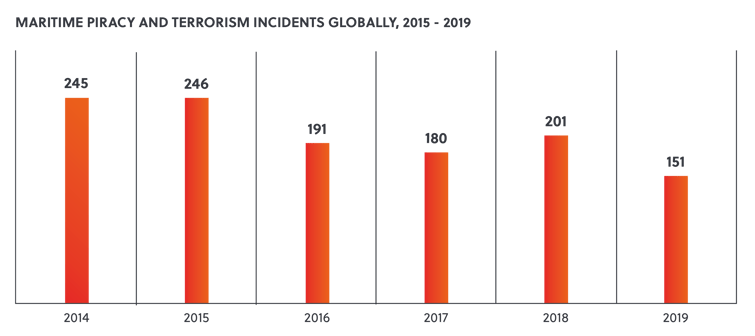
TRENDS
In 2019, bulk carriers, product tankers and container vessels were most commonly targeted – particularly by pirates – likely, in part, due to their lootable cargo. According to Patrick Rogers, a maritime security expert at S-RM, feeders and coastal tankers are also targeted due to their slow speed and predictable transit routes. Further trends for 2019 – largely mirroring patterns over the past five years – indicated that:
- Most attacks have taken place while vessels were in anchorage;
- The most frequently-targeted anchorages were Lagos, Nigeria and Callao, Peru;
- Around 52 percent of maritime kidnappings took place in Nigerian waters; and,
- Knives and firearms were the most commonly-used weapons during attacks, although they were mainly used to threaten crew members rather than to harm them.
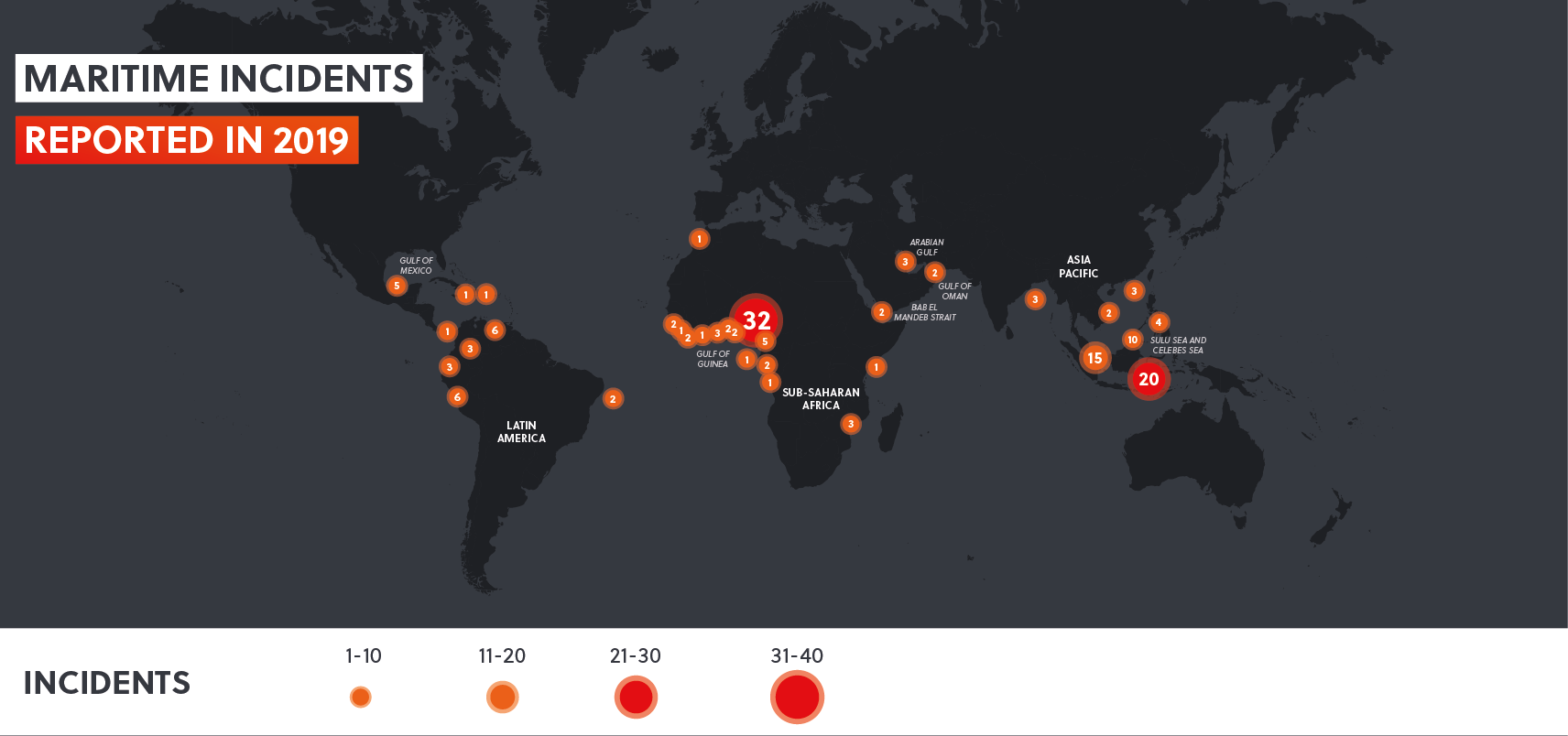
PIRACY IN SUB-SAHARAN AFRICA
THREAT ACTOR: CRIMINAL GANGS
HOTSPOTS: NIGER DELTA; BONNY ISLAND
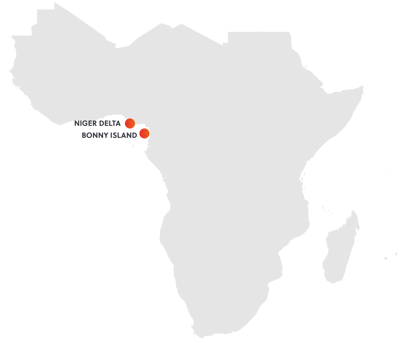 In Sub-Saharan Africa, piracy in the Gulf of Guinea (GoG) represents the most prevalent threat to commercial shipping. In 2019, the GoG represented around 38 percent of incidents recorded globally.
In Sub-Saharan Africa, piracy in the Gulf of Guinea (GoG) represents the most prevalent threat to commercial shipping. In 2019, the GoG represented around 38 percent of incidents recorded globally.
Pirates operating in the Niger Delta area are the main threat to commercial vessels, and have demonstrated the ability to target ships along most of the GoG coastline. Heavily-armed perpetrators typically approach vessels in several skiffs, robbing crew and stealing equipment before escaping. Pirates sporadically kidnap crew for ransom during attacks, and foreigners are considered high-value targets, as demonstrated when pirates kidnapped 19 foreign nationals from an oil tanker leaving Bonny Island in the southern Delta in December 2019.
According to Rogers, pirates in the GoG have displayed a greater appetite for targeting vessels with an on-board security presence than in other regions. They readily engage security personnel both onboard and in escort vessels, increasing the potential for crew to be injured or killed, and for cargo to be damaged in the crossfire.
KIDNAP IN ASIA PACIFIC
THREAT ACTOR: ABU SAYYAF GROUP, OPPORTUNISTIC CRIMINALS
HOTSPOTS: SULU-CELEBES SEAS; SOUTH CHINA SEA; SINGAPORE STRAITS
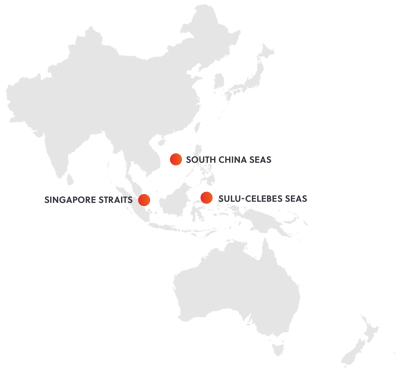 While the region remains a high-threat environment, a drastic increase in surveillance efforts and maritime patrols over the past few years have improved the overall security situation. Authorities reported an estimated 16 percent decrease in regional maritime incidents from January to September 2019, compared to the same period in 2018.
While the region remains a high-threat environment, a drastic increase in surveillance efforts and maritime patrols over the past few years have improved the overall security situation. Authorities reported an estimated 16 percent decrease in regional maritime incidents from January to September 2019, compared to the same period in 2018.
The primary threat remains Abu Sayyaf Group (ASG) militants who kidnap crew for ransom in the Sulu-Celebes seas, and near eastern Sabah, to fund terrorist activities. At least 13 people were kidnapped from fishing vessels in two incidents off the Malaysian coast in 2019. While those kidnapped were mostly local fishermen, ASG has previously targeted foreign nationals due to the perception that they would fetch a greater ransom.
Pirates in the South China Sea, and the Malacca and Singapore straits, are a further threat to commercial vessels, commonly targeting bulk carriers and product tankers to steal stores. In 2019, there was a reported uptick in such incidents around the Indonesian and Malaysian coastline, with 20 and 10 incidents reported respectively. However, incidents suggest that perpetrators aim to operate clandestinely without alerting or harming the crew, and attempt to quickly escape when discovered, rather than confront on-board security.
ROBBERY AND FUEL THEFT IN LATIN AMERICA
THREAT ACTOR: ORGANISED CRIMINAL GROUPS
HOTSPOTS: GULF OF MEXICO; PERUVIAN, AND VENEZUELAN COASTLINES
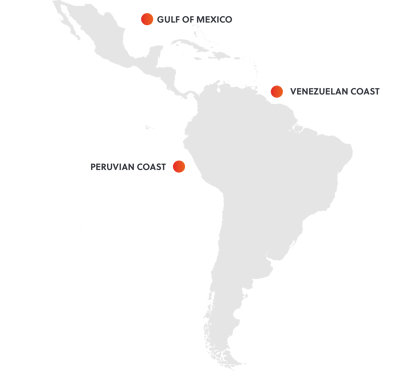 In 2019, most incidents took place in the Gulf of Mexico (GoM) and along the northern coastline of South America. Members of Organised Criminal Groups (OCGs), as well as opportunistic criminals, regularly target vessels to steal cargo, equipment or crew members’ possessions to sell on the black market.
In 2019, most incidents took place in the Gulf of Mexico (GoM) and along the northern coastline of South America. Members of Organised Criminal Groups (OCGs), as well as opportunistic criminals, regularly target vessels to steal cargo, equipment or crew members’ possessions to sell on the black market.
Mexican authorities have stated that attacks targeting supply vessels in the GoM – where the Mexican state-owned PEMEX oil company operates several offshore oil rigs – occur daily, although there is limited data available to verify such incidents. Criminals commonly target supply service vessels as they are easily accessible due to their low freeboards, and often carry excess resources and fuel. Huachicoleros (fuel siphoners) are a further threat to commercial vessels in the GoM. In January 2019, authorities discovered 800,000 litres of siphoned fuel during two vessel detentions at Dos Bocas Port, Tabasco State. Criminals have also looted vessels while in anchorage, particularly at the ports of Ciudad del Carmen, Campeche and Tabasco.
GEOPOLITICAL TENSIONS IN THE MIDDLE EAST
THREAT ACTOR: IRAN, HOUTHI MILITANTS
HOTSPOTS: BAB EL MANDEB STRAIT; ARABIAN GULF
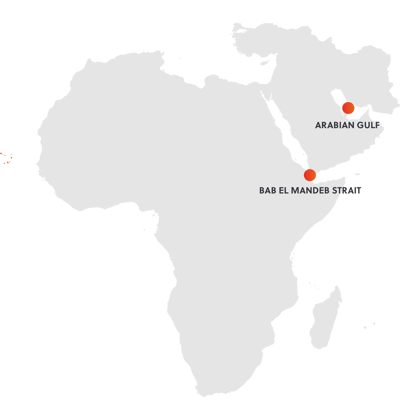 In 2019, escalating geopolitical tensions in the Arabian Gulf prompted concerns that Iran and the US would engage in a naval stand-off. While no such confrontation occurred, three attacks on commercial tankers in May and June – as well as several retaliatory detentions by Iranian authorities of vessels perceived to support the US – demonstrated that heightened tensions can significantly disrupt shipping in the area. Iran has also historically threatened to close the Strait of Hormuz in case of an inter-state war, which would disrupt global oil shipments. The threat environment remains volatile – particularly while US-Iran relations remain fraught – prompting uncertainty regarding vessel and crew safety in the area.
In 2019, escalating geopolitical tensions in the Arabian Gulf prompted concerns that Iran and the US would engage in a naval stand-off. While no such confrontation occurred, three attacks on commercial tankers in May and June – as well as several retaliatory detentions by Iranian authorities of vessels perceived to support the US – demonstrated that heightened tensions can significantly disrupt shipping in the area. Iran has also historically threatened to close the Strait of Hormuz in case of an inter-state war, which would disrupt global oil shipments. The threat environment remains volatile – particularly while US-Iran relations remain fraught – prompting uncertainty regarding vessel and crew safety in the area.
Yemen-based Houthi militants sporadically attack vessels in the Bab El Mandeb Strait and the western Yemeni coastline, amid an ongoing insurgency against the government. Although their capabilities have largely declined over the past few years due to increased Saudi-led efforts to protect the Strait – one of the most-travelled tanker routes – Houthis retain the ability to plant sea-mines or occasionally hijack vessels and detain crew. Houthis mainly target vessels belonging to countries of supporting government forces, although other vessel nationalities have also been targeted in isolated cases.
INDIRECT THREAT: CIVIL UNREST
- Demonstrations in the vicinity of ports can disrupt port operations, and in turn delay commercial activities.
- For example, anti-government protesters in Iraq blocked and forced the closure of Umm Qasr port near Basra in November 2019, decreasing port operations by 50 percent and preventing tankers from entering or leaving.
VESSEL SECURITY
When transiting through high-threat areas, Rogers suggests that the European Union Naval Force’s (EUNAVFOR) Best Management Practices (BMP5) is a good starting point for preventive vessel hardening measures, due to the tried-and-tested advice provided in the guidelines. However, Rogers also advises that threats specific to the vessel’s operating environment require additional consideration.
Read our 2020 Travel Security Special Edition for more global security insights.
